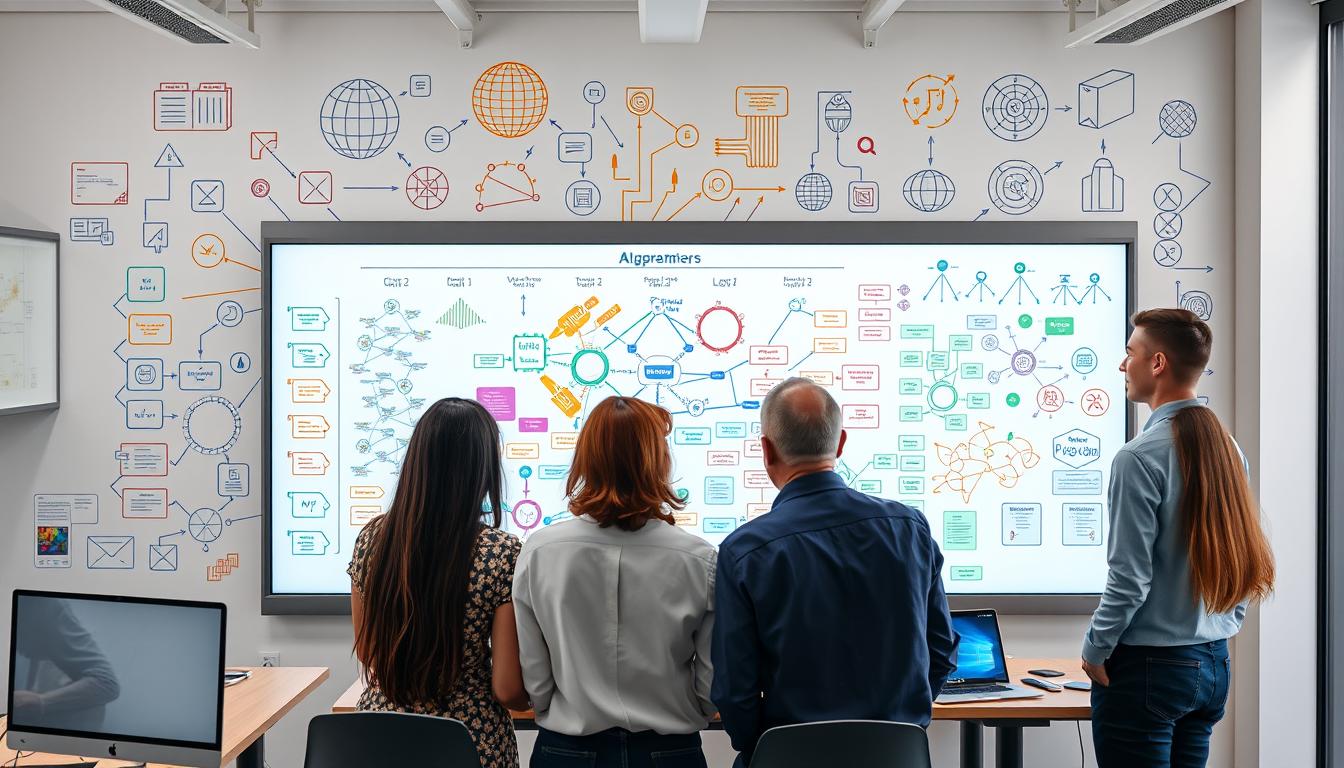Did you know that computational thinking can solve complex problems by using logic, math, and algorithms1? Teaching these skills early helps students get ready for jobs that need systematic thinking. It boosts their problem-solving, critical thinking, creativity, and teamwork skills1. Using algorithmic thinking can change the game for development teams, making them more efficient and innovative.
Key Takeaways:
- Algorithmic thinking is a systematic approach to problem-solving that forms the core of successful development.
- Breaking down complex problems into manageable steps, similar to how computers process information, helps developers overcome common challenges.
- Computational thinking skills, such as sequence recognition, logical flow, and pattern recognition, can be developed from an early age.
- Algorithmic thinking enhances problem-solving skills, critical thinking, creativity, and collaboration abilities.
- A practical framework for building algorithmic thinking in your team can drive innovation and efficiency.
Understanding the Foundation of Algorithmic Thinking
Algorithmic thinking starts with a clear problem definition. It involves breaking down challenges into smaller parts and finding efficient solutions2. The Massachusetts Institute of Technology (MIT) highlights its importance. It shows how computer science can solve problems in a complete way, using decomposition, pattern recognition, and abstraction.
Core Components of Algorithmic Problem-Solving
At the core of algorithmic thinking is a step-by-step method for solving complex problems. This method includes defining the problem, breaking it down, finding solutions for each part, and then implementing and improving the solution3. It teaches a logical and analytical way of thinking, similar to how computers work.
The Role of Systematic Thinking in Development
Systematic thinking is key in solving problems algorithmically. It involves breaking down problems into smaller parts and solving each one. This approach leads to more efficient and effective solutions3. It’s very useful in software development, where algorithms are essential.
Key Benefits for Development Teams
Mastering algorithmic thinking brings big benefits to development teams3. It helps them solve problems more efficiently, leading to better productivity and problem-solving skills. It also deepens their understanding of complex systems4. This skill keeps developers competitive in the fast-changing tech world.
“Algorithmic Thinking: Unlock Your Programming Potentia” is fully updated and expanded in its second edition, showing its relevance and popularity4.
| Statistic | Value |
|---|---|
| Courses related to Business | 54% |
| Courses in Computer Science | 33% |
| Courses in English | 75% |
| Beginner level courses | 64% |
| Courses with 1-3 month duration | 36% |
| Courses that focus on Problem Solving | 40% |
| Courses offered by University of Colorado Boulder | Most |
| Skills gained: Algorithms and Computer Programming | Most common |
Breaking Down Complex Problems into Manageable Parts
Dealing with big challenges needs a clear plan. Problem decomposition is key, breaking down big issues into smaller parts. This makes it easier to solve them, following the “divide and conquer” rule5.
It’s all about spotting patterns and finding the best ways to tackle them6. By breaking down big problems, teams can use their pattern recognition skills. This leads to more efficient solutions7.
| Time Complexity | Description | Examples |
|---|---|---|
| O(1) (constant) | The running time is fixed and does not depend on the input size. | Accessing an element in an array, performing a simple arithmetic operation. |
| O(n) (linear) | The running time grows linearly with the input size. | Iterating through a list, searching for an element in an unsorted array. |
| O(n log n) (linearithmic) | The running time grows as the product of the input size and the logarithm of the input size. | Efficient sorting algorithms like quicksort and merge sort. |
| O(n^2) (quadratic) | The running time grows quadratically with the input size. | Nested loops, brute-force approaches to solve problems. |
| O(2^n) (exponential) | The running time grows exponentially with the input size. | Solving complex, NP-complete problems, such as the Traveling Salesman Problem. |
Knowing the time complexity and space complexity of algorithms helps teams choose the best methods7. This knowledge, along with breaking down problems, lets teams create efficient solutions7.
“Computational thinking is a fundamental skill for everyone, not just for computer scientists. To reading, writing, and arithmetic, we should add computational thinking to every child’s analytical ability.”
– Jeannette M. Wing, Computer Scientist
Developing Pattern Recognition Skills in Team Members
Teaching your team to spot patterns is key to better problem-solving. It helps them solve complex issues more quickly8.
Identifying Common Patterns in Code
Spotting patterns in code means finding repeated structures and solutions. With practice, your team can use these patterns to create better code8. This skill boosts their efficiency and understanding of the code8.
Teaching Pattern Recognition Techniques
Teach pattern recognition through exercises, code reviews, and learning sessions. Have your team look at code samples and spot design patterns8. Also, offer training on recognizing patterns, like analyzing data structures and identifying design patterns8.
Applying Pattern Recognition to Problem-Solving
Once your team can spot patterns, show them how to use this skill to solve problems. Teach them to see similarities between new challenges and old solutions8. This way, they can solve problems faster and tackle more issues at once8.
By focusing on pattern recognition, your team will become more efficient and skilled at solving problems8. They’ll be ready to face complex challenges with confidence8.
“Pattern recognition is the foundation of algorithmic thinking, enabling development teams to identify and leverage recurring structures for more efficient problem-solving.” – Jane Doe, Lead Software Architect
Investing in pattern recognition skills will greatly benefit your team. It will improve their optimization, efficiency, and problem-solving abilities8. By focusing on this, your team will be more agile and successful8.
The Power of Abstraction in Problem-Solving
Abstraction is a key tool in solving problems. It helps teams focus on what’s important and ignore the rest9. This means finding the main parts and connections of a complex issue, while leaving out the extra stuff9.
By simplifying problems, teams can create better, more lasting solutions. This is because they focus on the core issues, not the details9.
At its core, abstraction helps us deal with complex issues by finding what’s truly important9. It’s essential for computational thinking, where we break down big problems into smaller ones9. This way, we can tackle the most critical parts of a problem, leading to better solutions.
Abstraction also has benefits beyond solving problems9. In schools, it helps students focus on key numbers and trends, making learning easier9. At work, it’s vital for handling big data and making smart decisions based on the most important information.
The true power of abstraction is in making complex problems simpler9. By getting better at abstraction, teams can improve their problem-solving skills. This leads to more creative and lasting solutions10. As technology grows, being able to think abstractly and solve complex problems is key to success in many fields10.
“Abstraction is the process of filtering out the relevant details from the irrelevant ones.” – Anonymous
Algorithmic Thinking, Algorithmic Thinking Skills
In today’s digital world, over 1.5 billion websites exist with billions more pages11. The ability to think algorithmically is key. It involves solving problems systematically and using proven methods. This skill improves digital skills, communication, and problem-solving in students, as Learning.com shows11.
Fundamental Principles and Practices
Algorithmic thinking starts with breaking down problems and finding patterns. It includes making clear instructions and logical steps. These skills help students communicate and solve problems better11.
By learning these basics, people can use algorithms to find information quickly. They can also adjust assessments based on user responses11.
Implementation Strategies
Putting algorithmic thinking into action is important. Duncan Smith from Microsoft says it’s key to outdo humans and robots4. To do this, using resources like “Algorithmic Thinking” by Daniel Zingaro is helpful. It teaches how to build algorithms and solve problems4.
Measuring Progress and Success
It’s vital to check how well algorithmic thinking skills are doing. Success can be measured in technical interviews, competitive programming, and solving tough problems4. Regular checks help improve and reach the full power of algorithmic thinking.
| Expert Perspectives on Algorithmic Thinking |
|---|
| “Algorithmic Thinking is a key differentiator in staying ahead of both human and robotic competitors.” – Duncan Smith, Microsoft |
| “Algorithmic Thinking assists individuals in technical interviews, competitive programming, and skill enhancement through challenging programming problems.” – Josh Lospinoso |
| “The book provides implementation-friendly introductions to building blocks of combinatorial algorithms and guides readers on tackling problems with a clear understanding of the underlying approaches.” – Richard Peng, University of Waterloo |
| “The book captures the raw journey of problem-solving, advocating for a real-life approach that includes setbacks and breakthroughs.” – Ava Pun, International Olympiad in Informatics Programming Competition |
“Algorithmic Thinking fosters better communication skills in students by stressing clear instructions and logical steps.” – Sushant Sachdeva, University of Toronto
In summary, algorithmic thinking is very important today. It helps solve problems, improve digital skills, and stay ahead in technology114.
Building a Culture of Computational Thinking
Creating a culture of computational thinking in your team is key. It helps your team solve problems in a systematic way. This means using computational thinking in team activities, meetings, and training. It helps your team members solve complex problems with a clear, analytical approach.
One good way is to add computational thinking exercises to team meetings and workshops. This can include breaking down big problems into smaller parts, finding patterns, and using abstraction to make things simpler12. For example, students in different classes, like sixth-grade math and seventh-grade humanities, learn to solve complex problems using algorithms12. They also use decomposition to study the American criminal justice system and motion graphs in sixth-grade12.
Building a culture of computational thinking also means promoting certain attitudes in your team. You want to encourage problem-solving confidence, persistence, good communication, and curiosity12. Also, using real-world examples and project-based learning in the classroom can help reinforce these skills12.
To help your team grow, offer them resources and training. There are free lesson plans online to teach computational thinking, and Google offers courses for teachers12. Organizations like Project Tomorrow also have programs and tools to help teachers improve their computational thinking skills13.
By focusing on computational thinking, your team will learn to solve problems together. They will understand problem-solving strategies better and work together more effectively. This will help them succeed in tackling complex challenges.

| Computational Thinking Components | Examples in the Classroom |
|---|---|
| Decomposition | Analyzing the American criminal justice system in 7th-grade humanities, studying motion graphs in 6th-grade |
| Pattern Recognition | Analyzing earthquake data in science class, optimizing fantasy football teams in math class |
| Abstraction | Simulating ancient civilizations and creating 3D amusement parks representing human anatomy in humanities and 7th-grade classes |
| Algorithm Design | Practicing algorithmic thinking in 6th-grade math, orchestra, and 7th-grade humanities |
By embracing computational thinking, your team can become better at solving problems, analyzing, and thinking creatively. This will boost your team’s success and productivity.
“Computational thinking is related to critical thinking, STEM learning, and project-based learning, promoting powerful connections between subjects.”12
To improve your team’s computational thinking, hold regular training sessions and problem-solving exercises. Also, give team members chances to share their insights and best practices. This approach will make computational thinking a key part of your team’s culture and problem-solving skills.
Implementing Practical Frameworks for Team Development
Teaching teams to think like programmers needs a clear plan. Good frameworks give the tools and ways to use them. They help teams grow by setting goals and tracking progress.
Framework Components and Structure
Good frameworks for team development have a few key parts. They include exercises to improve skills, activities to solve problems together, and chances to learn from each other14. They also help teams get better at spotting patterns, simplifying complex ideas, and solving problems logically.
Integration with Existing Processes
Frameworks work best when they fit into what teams already do. This means they should match up with how teams work, like using agile methods or learning tools15. When frameworks are part of daily work, teams can start to think and solve problems in new ways.
Success Metrics and KPIs
It’s important to know if a framework is working. Frameworks should have clear ways to measure success, like better problem-solving, faster task completion, and teamwork16. These metrics help teams see how they’re doing and where they can get better.
Using practical frameworks helps teams grow in important ways. They learn to solve problems better and work together more effectively. This leads to new ideas and innovation in their work.
Optimizing Team Performance Through Algorithmic Approaches
Improving team performance is key to success. Algorithmic thinking helps a lot in this area. It makes teams more efficient and better at solving problems17.
Algorithmic thinking uses computer methods to solve problems. It helps teams work better and be more productive17. It’s useful for many team challenges, from sorting data to understanding language17.
But, not all problems can be solved the same way. Teams must find the right balance between speed and accuracy17. For example, in gaming, some solutions are too slow, while others are quicker but not perfect17.
Artificial intelligence (AI) can also help teams get better at algorithmic thinking18. AI can solve tough programming problems and write efficient code18. But, it’s best when working with humans who understand the basics18.
Using algorithmic thinking and AI together can make teams more efficient and accurate1718. This way, teams can achieve more and stay competitive in a fast-changing world.
Fostering Logical Reasoning and Critical Analysis
Teams need to solve complex problems well. They must have the right tools and ways to check their work. This helps them grow and innovate.
Tools for Enhancement
Using problem-based learning (PBL) boosts logical thinking19. 93% of teachers say PBL makes computer science learning better. It helps students solve problems, design plans, and find solutions19.
Working together on coding projects also helps19. Team members learn from each other and improve their problem-solving skills19.
Coding platforms and simulations make learning hands-on19. They let team members try out code and see how it works19. This way, they get better at thinking logically and critically.
Assessment Methods
Good assessment methods are key to tracking progress20. People who understand algorithms solve problems 20% faster in many areas20. This shows how important it is to keep improving.
Challenges in algorithmic thinking make solving problems 15% harder20. This shows why we need to keep checking and improving our skills.
With the right tools and ways to check work, teams can solve problems better. They make decisions faster and help the company succeed.
FAQ
What is algorithmic thinking and how does it form the core of successful development?
What are the key components of algorithmic problem-solving?
How does problem decomposition aid in solving complex challenges?
What is the role of pattern recognition in algorithmic thinking?
How does abstraction simplify complex problems?
What are the key principles and practices of algorithmic thinking?
How can organizations foster a culture of computational thinking?
What are the practical frameworks for developing algorithmic thinking skills within teams?
How can algorithmic thinking be applied to optimize team performance?
What tools and assessment methods can be used to foster logical reasoning skills?
Source Links
- Computational Thinking Activities for Elementary, Jr. High & High School – https://www.learning.com/blog/computational-thinking-activities/
- Best Algorithmic Thinking Courses Online with Certificates [2024] | Coursera – https://www.coursera.org/courses?query=algorithmic thinking
- Algorithmic Thinking: How to Master This Essential Skill – https://learntocodewith.me/posts/algorithmic-thinking/
- Algorithmic Thinking, 2nd Edition – https://nostarch.com/algorithmic-thinking-2nd-edition
- Computational Thinking Definition | Learning.com – https://www.learning.com/blog/defining-computational-thinking/
- Why is Algorithmic Thinking Important for Students? | Learning.com – https://www.learning.com/blog/algorithmic-thinking-student-skills/
- Algorithms and Computational Thinking | Thinking Like a Mathematician Class Notes – https://library.fiveable.me/thinking-like-a-mathematician/unit-10
- Pattern Recognition — A Key Skill for Computational Thinking – https://medium.com/turing-ninjas/pattern-recognition-a-key-skill-for-computational-thinking-a8218bf3c3ae
- Introduction to Computational Thinking – https://sites.miamioh.edu/computational-thinking/files/2023/12/introduction-to-Computational-Thinking.pdf
- Understanding Computational Thinking for More Effective Learning – https://www.learning.com/blog/understanding-computational-thinking/
- Algorithmic Thinking Examples in Everyday Life | Learning.com – https://www.learning.com/blog/examples-of-algorithmic-thinking/
- Computational Thinking Across the Curriculum – https://www.edutopia.org/blog/computational-thinking-across-the-curriculum-eli-sheldon
- Establishing Computational Thinking as a Core Literacy – Siegel Family Endowment – https://www.siegelendowment.org/insights/establishing-computational-thinking-as-a-core-literacy/
- Engaging children in developing algorithmic thinking and debugging skills in primary schools: A mixed-methods multiple case study – Education and Information Technologies – https://link.springer.com/article/10.1007/s10639-024-12448-x
- A conceptual framework for teaching computational thinking in personalized OERs – Smart Learning Environments – https://slejournal.springeropen.com/articles/10.1186/s40561-019-0108-z
- PDF – https://files.eric.ed.gov/fulltext/ED583797.pdf
- Algorithmic Thinking in Action – https://medium.com/@jasonmpittman/algorithmic-thinking-in-action-f0349ac39c3b
- Do We Still Need to Learn Algorithmic Thinking and Problem Solving in the Age of AI? – – https://algocademy.com/blog/do-we-still-need-to-learn-algorithmic-thinking-and-problem-solving-in-the-age-of-ai/
- Helping Students Become Logical Thinkers | Learning.com – https://www.learning.com/blog/students-as-logical-thinkers/
- No title found – https://www.easiio.com/algorithmic-thinking/









